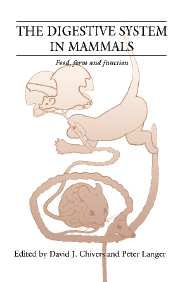Book contents
- Frontmatter
- Contents
- List of contributors
- Preface
- Part I Introduction
- Part II Food
- Part III Form
- 12 The form of selected regions of the gastro-intestinal tract
- 13 Categorisation of food items relevant to oral processing
- 14 A direct method for measurement of gross surface area of mammalian gastro-intestinal tracts
- 15 Morphometric methods for determining surface enlargement at the microscopic level in the large intestine and their application
- 16 Weaning time and bypass structures in the forestomachs of Marsupialia and Eutheria
- 17 Adaptations in the large intestine allowing small animals to eat fibrous foods
- Part IV Function
- Part V Synthesis and perspectives
- Index
14 - A direct method for measurement of gross surface area of mammalian gastro-intestinal tracts
Published online by Cambridge University Press: 18 March 2010
- Frontmatter
- Contents
- List of contributors
- Preface
- Part I Introduction
- Part II Food
- Part III Form
- 12 The form of selected regions of the gastro-intestinal tract
- 13 Categorisation of food items relevant to oral processing
- 14 A direct method for measurement of gross surface area of mammalian gastro-intestinal tracts
- 15 Morphometric methods for determining surface enlargement at the microscopic level in the large intestine and their application
- 16 Weaning time and bypass structures in the forestomachs of Marsupialia and Eutheria
- 17 Adaptations in the large intestine allowing small animals to eat fibrous foods
- Part IV Function
- Part V Synthesis and perspectives
- Index
Summary
In early literature, gastro-intestinal tracts (GIT) are described with subjective terms such as ‘large’, ‘small’, ‘long’, ‘short’, or ‘capacious’ (e.g. Boker, 1932; Hill, 1958). Comparison of the size of the GIT of a particular species requires a reliable quantitative method. Length of the small intestine, caecum and colon has been used by ornithologists interested in GIT morphology (e.g. Davis, 1961; Levin, 1963; Moss, 1972, 1974; Ankey, 1977; Pulliainen, 1981; Pulliainen et al, 1981; Pulliainen and Tunkkari, 1983) and by a few researchers in mammalogy (Barry, 1977; Schieck and Millar, 1985; Woodall, 1987), but length does not reliably indicate volume and, therefore, the capacity of a GIT.
Measurements of volume have been difficult to obtain. Chivers and Hladik (1980) attempted to measure volume of GIT regions using three different techniques. Filling a gut region with water was deemed inaccurate because of the tendency for GIT tissue to expand and, thus, give an inaccurate measurement. A second method, used for the stomach only, relied on a mathematical estimation based upon the length of the greater curvature in which this length was assumed to be equal to the circumference of a sphere. The third method relied on measurements of surface area for the stomach, which was assumed to be a sphere, and measurements of lengths and widths for the small intestine and colon, which were assumed to be cylinders. In their paper, the volume data were reported by use of the latter method. Chivers and Hladik (1980) recognized the potential problems concerned with the inaccuracy of these measurements.
- Type
- Chapter
- Information
- The Digestive System in MammalsFood Form and Function, pp. 219 - 233Publisher: Cambridge University PressPrint publication year: 1994
- 2
- Cited by



